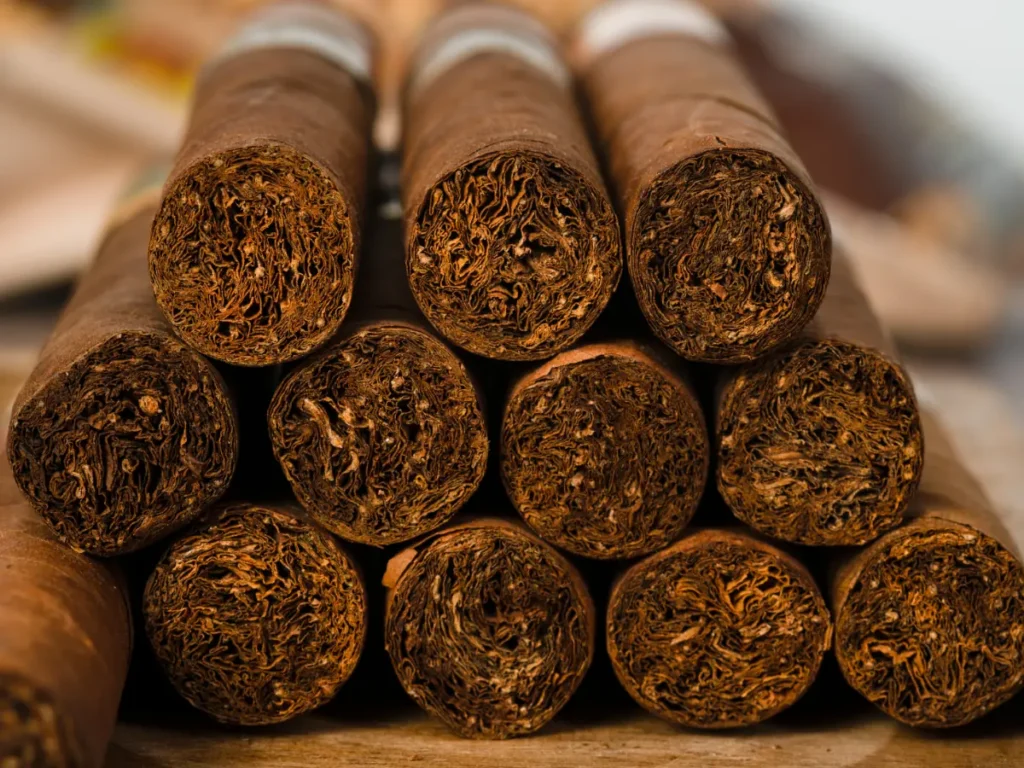Cigars have been a symbol of luxury and leisure for centuries, celebrated for their rich flavors and relaxing qualities. Yet, one question often arises among enthusiasts and curious minds alike: Do cigars have nicotine, and how do their nicotine levels compare to other tobacco products like cigarettes?
This article dives deep into the facts, dispels common myths, and offers insights into nicotine levels in cigars.
What is Nicotine?
Nicotine is a naturally occurring chemical compound found in tobacco plants. It belongs to a group of substances known as alkaloids, which plants produce to defend against pests.
Nicotine is synthesized in the roots of the tobacco plant and accumulates in its leaves, making it the key psychoactive ingredient in tobacco products.
Effects of Nicotine
Nicotine’s effects are a blend of short-term stimulation and long-term risks:
- Short-term effects: Nicotine triggers the release of dopamine, creating a temporary feeling of pleasure and relaxation. It also increases heart rate and blood pressure, causes dry mouth, and sharpens focus for some users.
- Long-term risks: Nicotine is highly addictive. Prolonged use can lead to withdrawal symptoms like irritability, restlessness, and strong cravings. Chronic exposure can also contribute to health problems, including cardiovascular issues and complications in other bodily systems.
The mix of pleasurable sensations and risks explains nicotine’s appeal and its hold on tobacco users.
A Brief History of Nicotine

The term “nicotine” originates from Jean Nicot, a French diplomat credited with introducing tobacco to Europe in the 16th century. Initially, tobacco was used medicinally and recreationally, gaining popularity across Europe between the 17th and 19th centuries.
By the mid-19th century, scientific advancements began unraveling nicotine’s true nature. Once thought to have healing properties, nicotine became recognized for its addictive and potentially harmful effects. This shift laid the foundation for modern discussions about tobacco use and its health implications.
Understanding Nicotine in Cigars
Nicotine is a fundamental component of tobacco, and cigars are no exception. The cigar-making process, from fermentation to aging, plays a significant role in determining nicotine levels.
The Manufacturing Process
- Fermentation: Tobacco leaves undergo fermentation, during which heat and moisture reduce nicotine content by breaking it down into simpler molecules. This process also enhances flavor.
- Aging: Aged tobacco develops unique aromas, often accompanied by an ammonia-like scent. Aging can slightly alter nicotine levels while refining the cigar’s overall profile.
Factors Influencing Nicotine Content
- Tobacco blend: Cigars are crafted from specific blends of tobacco leaves, which influence nicotine strength.
- Leaf type: The type of leaf used—wrapper, filler, or binder—affects the final nicotine concentration.
- Size and shape: Larger cigars typically contain more tobacco and, therefore, higher nicotine levels.
It’s worth noting that a cigar’s strength (or “spiciness”) doesn’t always correlate with nicotine content—a common misconception among smokers.
Nicotine Levels in Cigars

The nicotine content in cigars varies widely, typically ranging from 100 to 400 milligrams, depending on size and type. For comparison, cigarettes usually contain 10–12 milligrams of nicotine, with about 1 milligram absorbed per cigarette smoked.
Cigar strength is often categorized on a standardized scale:
- Light or mild
- Mild-medium
- Medium
- Medium-full
- Strong or full
The wrapper plays a significant role in determining strength, as darker wrappers often indicate richer flavor profiles and slightly higher nicotine levels.
Nicotine Absorption in Cigar Smoking
Unlike cigarette smokers, who often inhale deeply, cigar smokers usually take longer, slower puffs without inhaling into their lungs. This smoking method significantly reduces the amount of nicotine absorbed.
- Absorption rates: Cigar smokers typically retain 1–4.5 milligrams of nicotine per session, far less than the total nicotine content of the cigar itself.
- Experience differences: Cigars are designed for savoring flavors, not rapid nicotine delivery, which creates a more leisurely smoking experience.
Health Effects of Nicotine in Cigars
Nicotine in cigars can have both short-term and long-term effects:
Short-Term Effects
- Nausea, particularly in inexperienced smokers
- Increased heart rate and blood pressure
- Dry mouth and mild dizziness
Long-Term Risks
Even without inhalation, nicotine dependency can develop. Prolonged use may lead to:
- Hypertension and other cardiovascular issues
- Gastrointestinal problems
- Reduced fertility in both men and women
- Lower bone density
While cigars are often considered less harmful than cigarettes, they still carry risks, especially for frequent smokers.
Nicotine Retention
Nicotine remains in the body for up to three days after smoking. The rate at which it clears depends on several factors:
- Hydration: Drinking water helps flush nicotine from the system.
- Exercise: Physical activity boosts metabolism and accelerates clearance.
- Diet: Nutrient-rich foods aid detoxification.
- Sleep: Proper rest supports the body’s natural elimination processes.
Cigar Wraps and Nicotine Content
All tobacco products, including cigar wraps, contain nicotine. The wrapper leaf contributes to a cigar’s overall flavor and strength, with shade-grown wrappers tending to have milder characteristics compared to sun-grown varieties.
Measuring Nicotine in Tobacco Leaves
Nicotine levels vary across different parts of the tobacco plant:
- Leaves: The highest concentration of nicotine is found in the leaves, particularly those near the top of the plant.
- Stems: Contain less nicotine but are still used in some blends.
- Wrapper leaves: Their nicotine strength depends on factors like growing conditions (e.g., shade-grown vs. sun-grown) and curing techniques.
The careful blending of tobacco leaves allows cigar makers to create distinct flavor profiles and nicotine strengths.
Final Thoughts

Cigars undeniably contain nicotine, with levels influenced by their size, type, and manufacturing processes. While cigar smoking typically involves less nicotine absorption than cigarette smoking, it still carries potential health risks. Understanding these factors allows smokers to make informed choices.
For those who enjoy cigars, moderation and awareness are key. Savoring a cigar responsibly can be a pleasurable experience, but it’s essential to recognize its impact on your health and well-being.

Leave a Reply